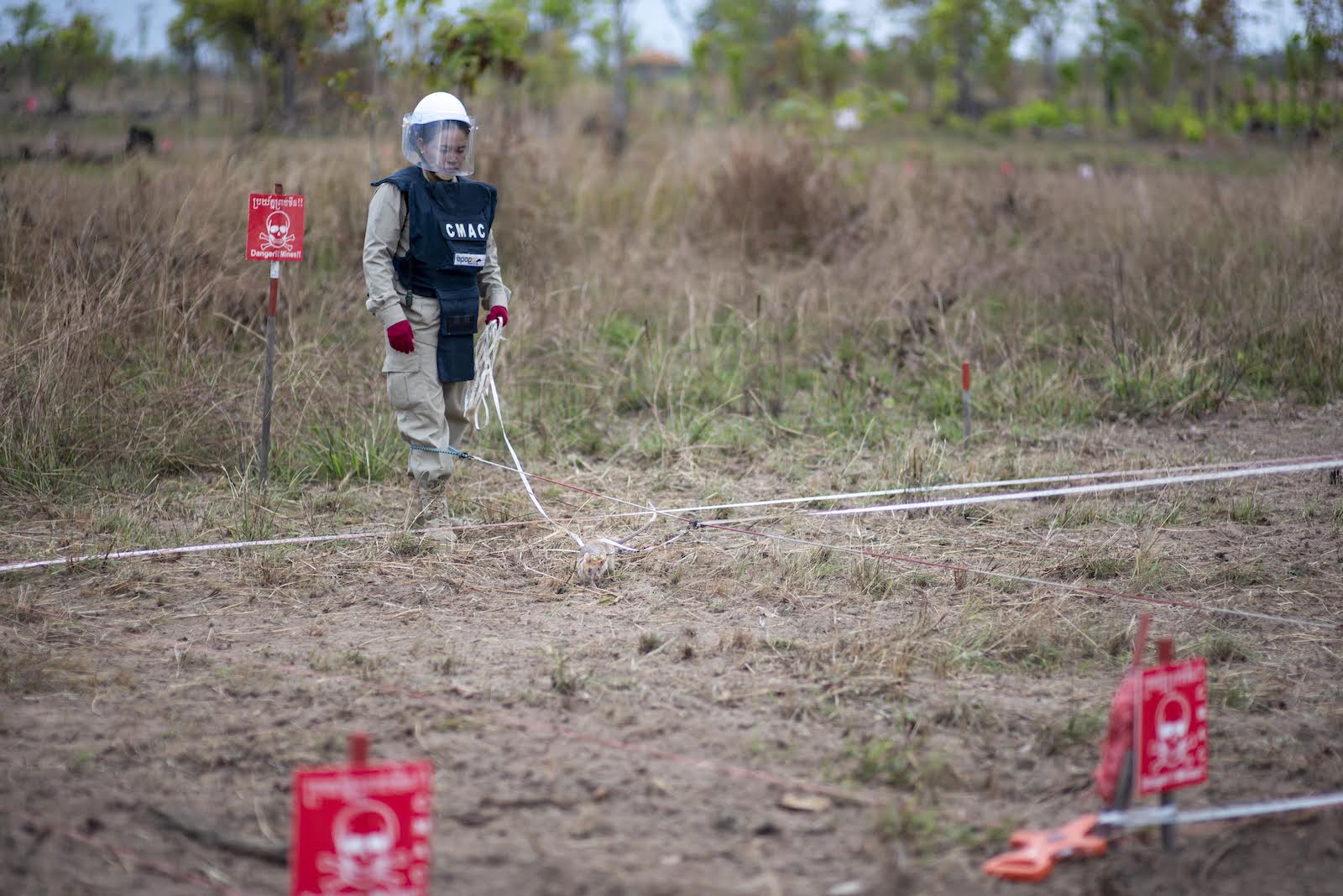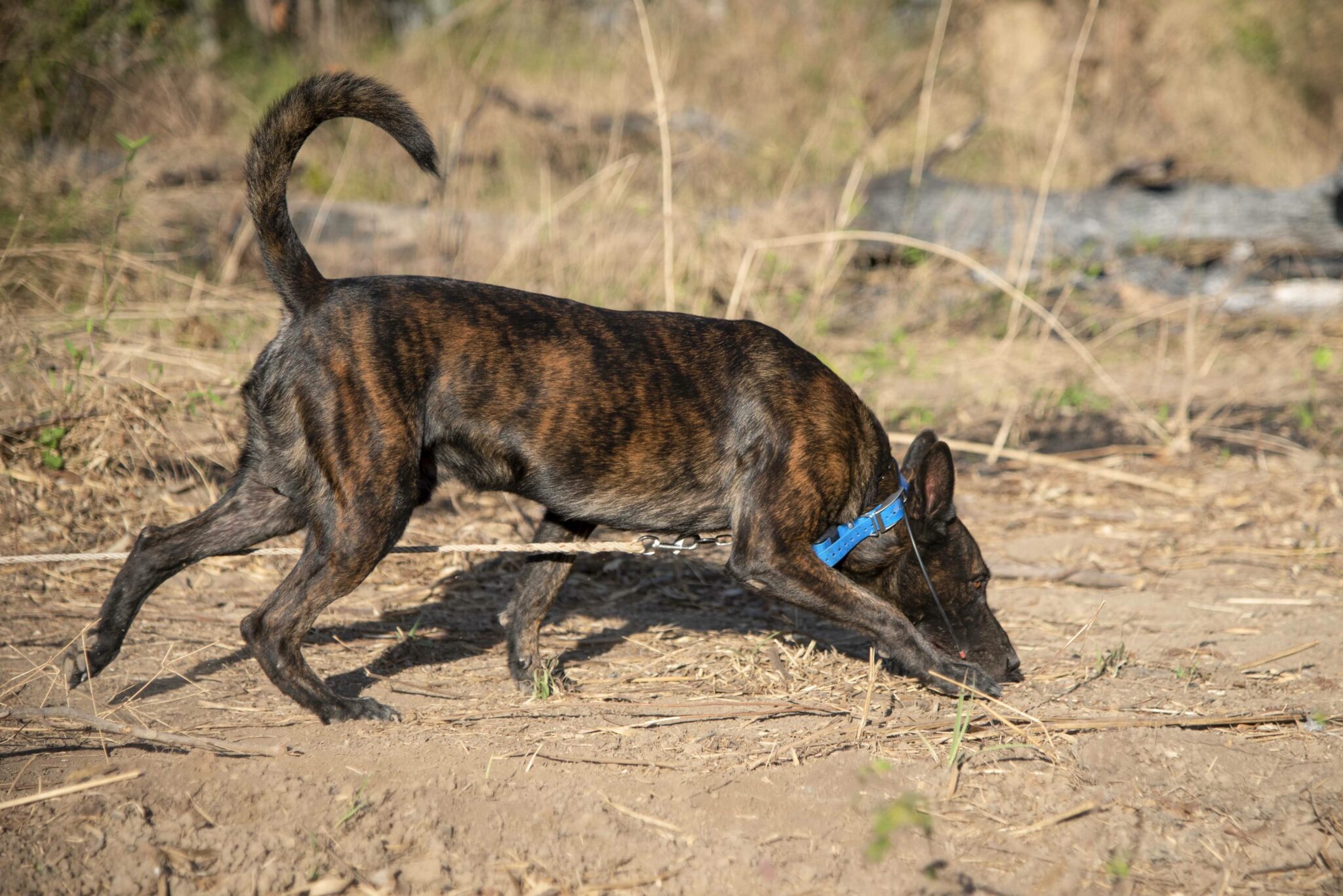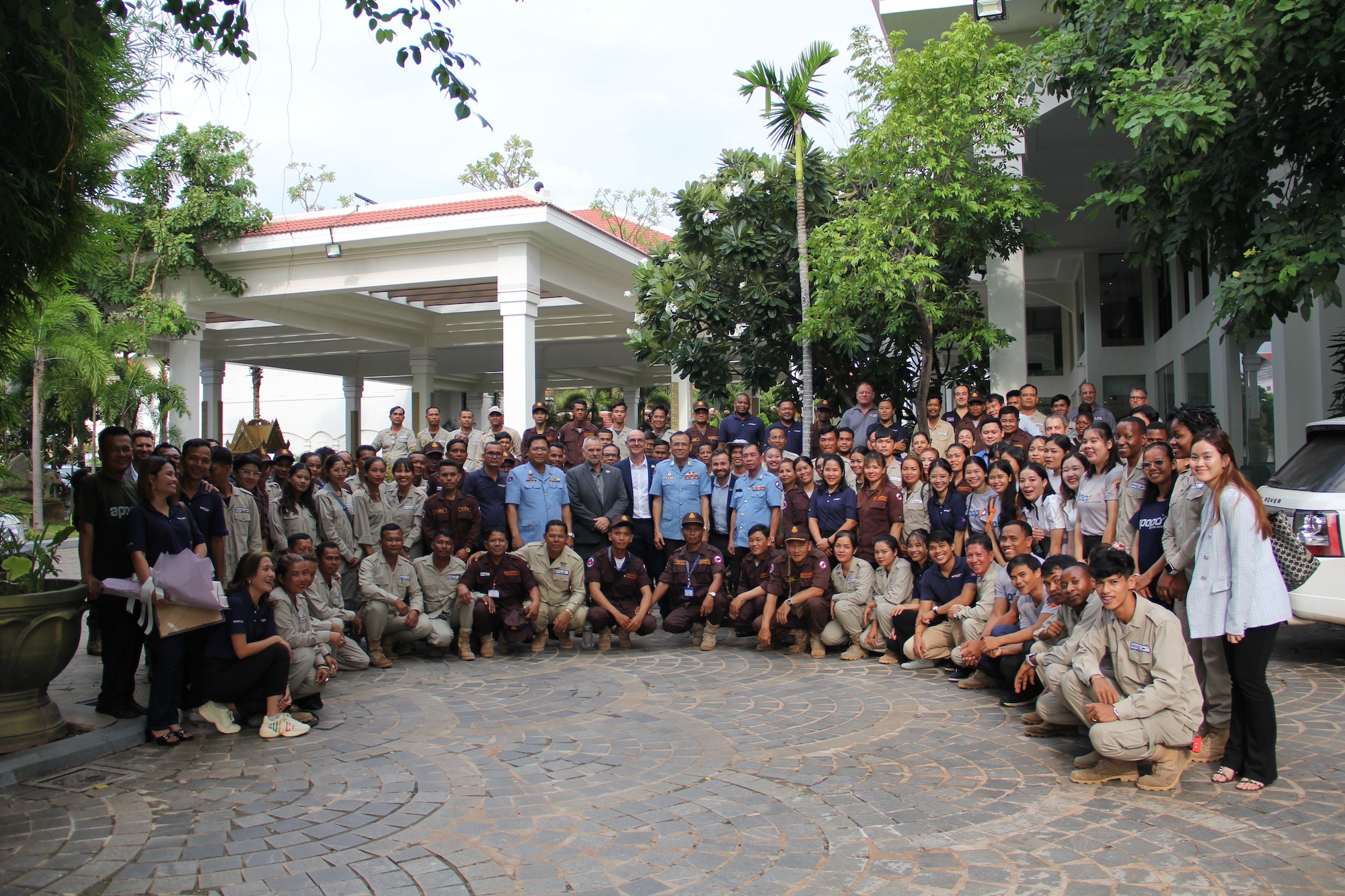On September 17th, APOPO proudly commemorated the 10-year anniversary of our humanitarian demining program in Cambodia. Over the past decade, our dedicated team, including our HeroRATs and Mine Detection Dogs, has worked tirelessly to clear landmines and unexploded ordnance (UXO), restoring safety and opportunities to communities across the country. None of this progress would have been possible without the incredible support of donors and supporters like you, who have been essential partners in this journey.

A Decade of Progress
Since January 2014, when APOPO began demining operations in Cambodia, we have partnered closely with national demining organization the Cambodian Mine Action Center (CMAC) and received critical funding from the German Federal Foreign Office (GFFO). Together, we set out to tackle the deadly threat posed by landmines and UXO that continue to endanger Cambodian communities.
Landmines in Cambodia are the legacy of decades of conflict, and today, Cambodia remains one of the most mine-affected countries in the world. Millions of landmines and unexploded munitions contaminate vast areas, injuring people and impeding development. Over the past ten years, thanks to the generous support of our donors and partners, APOPO has played a key role in helping Cambodia become a safer place for all to live.

APOPO’s Key Achievements in Cambodia in the Last 10 Years:
- 2,669 anti-personnel mines, 18 anti-tank mines, 2,441 UXO items, and 946 cluster munitions safely located and destroyed.
- Over 50,000 Cambodians directly impacted, with land returned for safe use in farming, housing, and infrastructure development.
- Mine Detection Rats (MDR) a.k.a HeroRATs introduced in 2015, significantly speeding up mine detection and clearance in highly contaminated areas.
- The Geneva International Centre for Humanitarian Demining (GICHD) endorsement in 2016, confirming the effectiveness of our Mine Detection Rats.
- The APOPO Visitor Center opened in Siem Reap, near the Angkor Wat temple, to educate visitors about the danger of landmines and how APOPO uses its HeroRATs and HeroDOGs to efficiently detect the explosives contained in hidden landmines and UXO.
- Technical Survey Dogs (TSDs) deployed in 2019, accelerating the identification and clearance of suspected hazardous areas.
- Partnerships with Mines Advisory Group (MAG) and Humanity & Inclusion (HI), expanding our reach and capacity to clear landmines and assist victims of landmines.
- Expansion of operations to the UNESCO World Heritage Site, Preah Vihear Temple, ensuring safe access for local residents and visitors while contributing to the preservation and development of the surrounding region.
- Launch of the ‘Minefields to Rice Fields’ initiative in 2023, converting cleared minefields into productive rice farming land and boosting farmers’ incomes by over 30%.
Innovation and Collaboration

Over the past decade, APOPO has prioritized innovation to enhance the speed, safety, and efficiency of mine clearance operations. In 2015, we brought our HeroRATs to Cambodia, where they swiftly demonstrated their effectiveness. Able to detect landmines up to 50 times quicker than conventional methods, our remarkable rats were strategically deployed in the most contaminated areas, ultimately saving many lives.
In 2016, the Geneva International Centre for Humanitarian Demining (GICHD) endorsed our Mine Detection Rat (MDR) program, confirming that the rats could significantly speed up our demining efforts without compromising accuracy or safety.

We continued to innovate in 2019 with the introduction of Technical Survey Dogs (TSDs), which further accelerated land release efforts by identifying areas requiring targeted clearance. This innovation has allowed us to conduct demining operations more efficiently, freeing up land for safe use more quickly.
Commemorating 10 Years in Cambodia
The 10-year anniversary event was held at the Courtyard by Marriott Hotel in Siem Reap. The event was attended by key stakeholders who have supported and contributed to the success of our program. Prum Sophakmonkol, Vice President of the Cambodian Mine Action and Victim Assistance Authority (CMAA), delivered a keynote address, acknowledging APOPO’s efforts and contributions to making Cambodia safer. Additional speakers included Michael Raine, APOPO’s Cambodia Program Manager, Michael Heiman, APOPO’s head of Mine Action and Christophe Cox, APOPO’s CEO, as well as representatives from the Belgium Embassy in Thailand, the British Embassy in Phnom Penh, and Cambodian government national clearance organization CMAC.

Christophe Cox, CEO of APOPO, said, “Today, APOPO Cambodia is a growing hub of our organization, facilitating South-South collaboration through the exchange of human expertise and trained animals between Tanzania, Cambodia, and the rest of the world. With partners like CMAC, we are now able to deploy our expertise in countries such as Azerbaijan and Ukraine.”
The event highlighted the major milestones achieved over the past decade and celebrated the critical role our donors and supporters have played in helping us work towards a mine-free Cambodia. Special moments included a video presentation showcasing 10 years of APOPO’s activities in Cambodia and an awards ceremony recognizing our staff’s outstanding contributions.
Acknowledging a Decade of Donor and Partner Support
APOPO recognizes that none of this progress would have been possible without the generous contributions of our donors and supporters. Your support, whether through donations, advocacy, or raising awareness, has been vital in helping APOPO make Cambodia safer. Your generosity has directly impacted thousands of lives, and we are deeply grateful.
Looking Ahead
Despite all our achievements, we also recognize the work that remains to be done. Cambodia’s goal of being mine impact-free by 2030, requires continued support to meet. With your help, APOPO remains committed to clearing the remaining minefields, ensuring future generations in Cambodia can live free from the fear of landmines.
How You Can Help
As we commemorate this milestone, we invite you to be part of this life-saving work. Your continued support will help accelerate the clearance of the remaining minefields, bringing safety and opportunity to more communities in Cambodia.
To learn more or to contribute to APOPO’s mission, visit our donation page. Together, we can continue making a difference and create a mine-free Cambodia.
Donate Today
Background information about Cambodia’s History of Landmine Contamination
Why Are There Landmines in Cambodia?
Cambodia remains one of the most mine-affected countries in the world, with millions of landmines and unexploded ordnance (UXO) scattered across the country, a legacy of decades of conflict. The density of landmines in Cambodia is among the highest in the world, resulting in one of the highest numbers of amputees per capita. The country’s troubled history, marked by the Vietnam War and the brutal rule of the Khmer Rouge, has left a lasting impact on the landscape, where an estimated 4 to 6 million unexploded landmines and UXO contaminate thousands of square kilometers of land.
During the Vietnam War, Cambodia, like its neighbors in Southeast Asia, Vietnam and Laos, was heavily bombed by U.S. forces targeting North Vietnamese troops operating within its borders. These bombing campaigns left behind a significant amount of UXO, which continues to pose a threat. Following the Vietnam War, the rise of the Khmer Rouge regime (1975–1979) led to widespread civil conflict, where landmines were used extensively by the regime and other factions to defend territories, disrupt enemy movements, and control populations. As a result, Cambodia now has one of the highest numbers of victims of landmines in the world.
The presence of landmines has led to frequent land mine accidents, affecting rural communities most severely. Many of these mines remain active today, hidden in farmlands, villages, and forests. The landmine contamination has created significant challenges for economic development, as vast areas of land remain dangerous or inaccessible. Cambodians face constant risk, and landmine accidents often result in fatalities or lifelong injuries. Cambodia has one of the highest number of amputees per capita in the world.
Efforts to clear these unexploded landmines, cluster bombs, cluster munitions and other unexploded ordnance have been underway for years, but progress has been slow due to the sheer number of landmines and the vast areas they cover. As of now, more than 2,000 Cambodian deminers are working tirelessly to locate and remove these deadly remnants of war. Despite these efforts, Cambodia’s journey to becoming mine-free continues to be a major challenge due to the massive area still contaminated by mines.
Cambodia became a signatory to the Anti-Personnel Mine Ban Convention in the late 1990s, committing to the goal of eliminating landmines. Since then, the Cambodian government, in collaboration with a network of development partners, has been working toward clearing the country of landmines and explosive remnants of war (ERW) by 2025.

